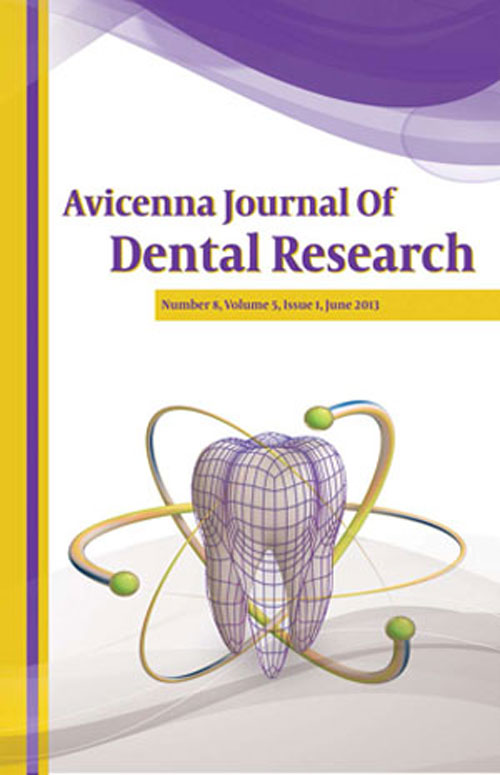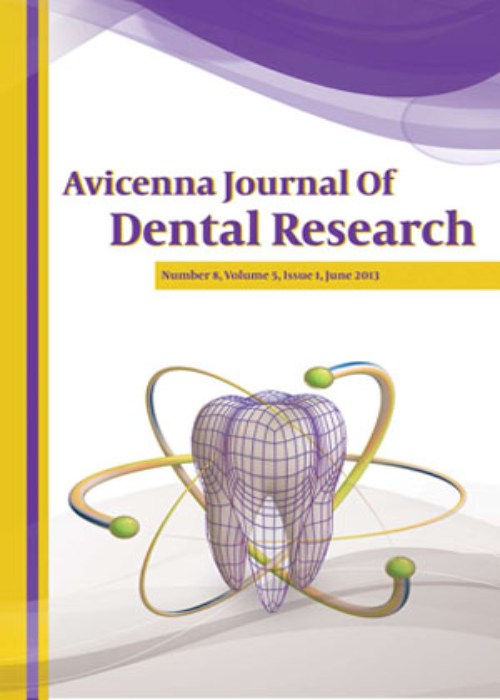فهرست مطالب

Avicenna Journal of Dental Research
Volume:9 Issue: 4, Dec 2017
- تاریخ انتشار: 1396/10/19
- تعداد عناوین: 8
-
-
Page 1BackgroundBurning mouth syndrome (BMS) is pain or burning sensation on the tongue or other mucosal membranes with at least 4 - 6 months duration and without clinical or laboratory findings. Its etiology is unknown and the prevalence varies across studies.ObjectivesThe current study aimed at evaluating the prevalence of BMS in female patients referred to Al-Zahra Hospital of Rasht, Iran, and investigating its related factors.MethodsA descriptive cross sectional study was conducted from March to December 2015. A total of 2400 females referred to the gynecological clinic of Al-Zahra hospital were examined and a researcher-made check list was completed. The diagnosis of BMS was based on patients self-report about burning sensation in the oral mucosa with no clinical symptoms in the oral cavity. After the check list was completed, the SPSS software version 16 was used for statistical analysis using chi-square and the Cramer test.ResultsAccording to the results of the current study, 3% of patients had burning mouth syndrome. The age range of most patients was 40 to 49 (54.2%) years and 38.9% of them were menopause. The most common sites of involvement were the tip of the tongue (33.3%), and lower lip (19.4%), respectively. The most common type of BMS was type 1 (51.4%). About 63.9% of participants had xerostomia; 9.7% of patients had para functional habits. No significant relationship was observed between oral hygiene, systemic disease, using denture, and BMS. There was a weak relationship between seasonal allergies and BMS.ConclusionsTo the authors best knowledge, BMS prevalence in the current study was consistent with that of international statistics. BMS more commonly affected females younger than 50 years old. About 65% of patients had xerostomia. Several factors may impact on BMS, but the effect is not yet definite.Keywords: Burning Mouth Syndrome, Xerostomia, Menopause
-
Page 2BackgroundDeveloping teeth may be evaluated based on the degree of tooth development or the stage of tooth eruption.ObjectivesThis study aimed to assess the accuracy of Demirjians method for dental age estimation in a group of Guilanian children.MethodsPanoramic radiographs of 390 Guilanian children aged 6 - 14 years were analyzed based on Demirjians method. Dental age was compared with chronological age using a paired t-test. The difference between the estimated age and chronological age was examined by Mann Whitney test in males and females.ResultsThe mean difference between the dental age and chronological age was 0.84 in females and 0.82 in males (about 8 months). The difference in this regard between males and females was not significant. The difference between the chronological and dental age was significant in all age groups except for 13 - 13.99 years old.ConclusionsDemirjians method may not be accurate enough for dental age estimation of Guilanian children and specific standards for dental age assessment should be developed for this population.Keywords: Dental Age, Chronological Age, Demirjian's Method
-
Page 3BackgroundGlass carbomers, such as GCP Glass Fill, are a type of GICs, which have nanosized apatite added to their composition. The manufacturer describes this material to have remineralizing properties.ObjectivesThis study aimed to evaluate the bioactivity of this material and the effect of finishing by thermocuring and gloss on its properties.MethodsBioactivity was measured by Ca and PO4 release studies, SEM, FT-IR, as well as EDX. Mechanical properties were measured by a compressive strength test.ResultsCements of all finishing types (with/without gloss and/or thermocuring) had comparable and acceptable initial compressive strengths. After an incubation period, all strengths decreased.ConclusionsAlthough GCP Glass Fill should be bioactive, no signs of bioactivity after incubation in SBF were observed. Moreover, the finishing conditions with Glass and thermocuring do not improve the mechanical properties of the cement. Therefore, this material is not superior to e.g. GICs.Keywords: Bioactivity, GCP Glass Fill, Glass Carbomer, Gloss, Thermocuring
-
Page 4BackgroundSkeletal age has been suggested for the assessment of puberty in patients, as chronological age is not reliable for this purpose.ObjectivesThis study aimed at determining chronological age based on the maturation stage of cervical vertebrae in the treatment of different malocclusions in a group of Iranian patients.MethodsThis cross- sectional analytical study was performed on 480 lateral cephalograms of patients aged 8 to 16 years (240 males and 240 females). The specimens were randomly selected from 480 patients who referred to a radiology center in Tehran. Patients were divided into 8 age groups. Cephalograms were traced by ViewBox software to determine the class of malocclusion. The cervical vertebral maturation stage (CVMS) was determined according to the Baccettis classification. Data were analyzed using SPSS.ResultsThe Pearsons correlation coefficient revealed a significant association between chronological age and CVMS in all patients with different classes of malocclusion (PConclusionsThe CVMS and skeletal age significantly increased with an increase in chronological age. However, high variability of chronological age at each CVMS showed that chronological age is not a reliable index for planning treatment for different malocclusions.Keywords: Cephalogram, Chronological Age, Skeletal Age, Cervical Vertebral Maturation, Malocclusion
-
Page 5BackgroundAchieving a high facial attractiveness is the main reason why Iranians tend to undergo such a surgery.ObjectivesAccordingly, the current study aimed at investigating the relationship between age, gender, education level, and perceived attractiveness of various nose profiles.MethodsVarious nose profiles were created by making changes in the 4 variables of the nose including alar width, tip shape, tip projection, and columella. Three images were provided in respect to each variable; a nose with a standard value, a nose with a more than standard value, and a nose with a lower than standard value. A total of 400 people (200 males and 200 females) were asked to rank each set of images based on their perceived attractiveness. In the next step, the effect of various factors such as age, gender, and education level on the perceived attractiveness was assessed. Chi-square test and SPSS software were utilized to perform statistical analyses.ResultsA standard profile had the highest level of attractiveness among participants. Moreover, profiles with values higher than the standard were the least attractive. There was no significant association between gender of participants and the perceived attractiveness of the nose profiles. The associations between education level and the perceived attractiveness of such variables as alar width in males, tip shape of males, columella in males, and tip projection in females were significant.ConclusionsIn conclusion, Iranian people prefer the average and standard nose. Age and gender had no effect on the perceived nose attractiveness, while the effect of education level was significant.Keywords: Rhinoplasty, Nose Profile, Beauty, Perceived Attractiveness
-
Page 6IntroductionAccurate diagnosis of root canal morphology and anatomy is essential for thorough shaping and cleaning of the entire root canal system and consequent successful root canal treatment. In a mandibular second premolar, it is rare to find extra roots and canals. The anatomy of the pulp chamber floor in premolars with more than one canal usually reveals one lingual and two buccal orifices at the same level.Case PresentationThis case report explains nonsurgical endodontic treatment of a mandibular second premolar with three separate canals and three separate mesiobuccal, mesiolingual, and distolingual orifices.DiscussionMandibular premolars have always proven to be an enigma to endodontist, as they exhibit a high degree of variability in their root canal morphology when compared to any other tooth in the oral cavity. Flat roots are much more likely to contain multiple canals and intercanal ramifications. In such cases, to obtain predictable results, high quality preoperative radiographs should be available at different horizontal angulations and carefully evaluated to detect the presence of extra root canals.Keywords: Endodontics, Root Canal Therapy, Anatomic Variation, Premolar
-
Page 7IntroductionOne-step apexification using mineral trioxide aggregate (MTA) has been reported as an alternative treatment modality with more benefits than the use of long-term calcium hydroxide (CaOH) for teeth with an open apex. However, the orthograde placement of MTA is a challenging procedure in terms of length control, especially in teeth with a wide-open apex. Therefore, we took advantage of the desirable properties of Ca(OH)2 in the formation of apical barriers in order to control the length of MTA during placement.Case PresentationWe would like to report the successful treatment of tooth 8 (in a 10-year-old girl) with an open apex and periapical lesions. In this case, we first used calcium hydroxide to form the primary apical barrier for six months and then we placed an MTA plug.ConclusionsBased on evidence, both MTA and Ca(OH)2 can be used for the endodontic treatment of non-vital immature teeth. In this case, we took advantage of special properties of MTA and Ca(OH)2 in apexification.Keywords: Apexification, Mineral Trioxide Aggregate, Open Apices, Calcium Hydroxide
-
Page 8IntroductionAlthough ectopic eruptions of teeth into the nasal cavity have been previously reported, the eruption of a tooth into the turbinates of the nose is quite rare. This report describes a case in which a tooth ectopically erupted into the inferior turbinate of the nose. Signs and symptoms of the occurrence, as well as its diagnosis and treatment, are also delineated in this case report.Case PresentationA 32-year-old man with swelling in the left paranasal area of the face was referred to the department of Oral and maxillofacial surgery for diagnosis and treatment. A diagnostic workup resulted in the diagnosis of an ectopic tooth eruption. The tooth was removed via the use of a transoral approach and without any complications.ConclusionsThis case report alerts surgeons to consider the possibility of an eruption of a tooth into the nasal cavity or inferior turbinate of the nose when panoramic radiography reveals an impacted canine tooth located high in the maxilla.Keywords: Tooth Eruption, Ectopic, Nasal Concha


